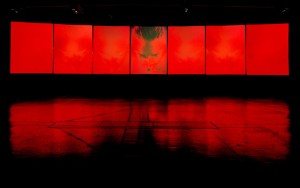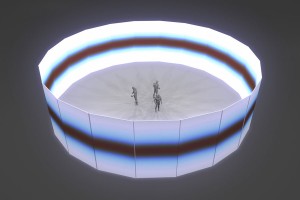First stop is Linz and Ars Electronica 2007. One minute I’m having lunch with a group of festival attendees, the next I’m in a taxi rushing back to my hostel, all the while attempting to explain my new mission as ANAT’s international roving reporter – in my minimal German – to the somewhat bemused taxi driver.Back at the hostel, I dig out my AV equipment and hurry back to the exact location we had not long since set off from. With microphones, hard-disk recorder, video camera, headphones and assorted cables in hand, I wait outside the press office for Kurt Hentschläger. He arrives, and as I extend my hand in greeting, half my equipment tumbles to the ground. So much for professionalism!
Opting for the closest café rather than one of the press interview rooms, Kurt and I find a place down the back to discuss his ultra-immersive work FEED (one of the main works featured at Ars Electronica 2007), his participation in the group Granular Synthesis, long-term involvement with computers and his interpretations of our future in such a technology-focused society. The first in this series of interviews with prominent media artists, theorists, thinkers and creators, the conversation takes an immediately engaging direction. Things bode well for my future reporting exploits.
Amsterdam
Next up Amsterdam, where Geert Lovink rolls up at the STEIM guesthouse on his bicycle. He’s dropping by on his way to the Institute of Network Cultures (of which he is the founding director), insisting it’s easier for him to come to me than vice versa. This is fortunate and fine by me, it’s far more convenient than dragging my equipment alongside Amsterdam’s canals! While unbelievably picturesque, these cobbled streets certainly weren’t designed with the modern techno-fetishist mobile citizen in mind. Or at least, not for those who insist on schlepping around a road-case full of gear.
Having become familiar with Geert’s writing during the early days of the fibreculture list [1] suddenly I feel that my interview questions are somehow inadequate. Geert, with his radio background, speaks with ease about the ‘growing pains’ of the new media arts, subversion of consumer technologies and the necessary context required for sustainability to become a real consideration. Naturally, the flavours of the minute – Web 2.0 and Facebook – pop up in the discussion. All food for thought…
Berlin
Germany again – this time Berlin. This is there city in which I currently reside, so while I’m still growing accustomed to the idea of actually living here – albeit in a somewhat transient fashion – I feel slightly more prepared when it comes to interviewing Marguerite Charmante, aka Margarete Jahrmann, in the midst of the noisy, overrun 2008 Transmediale festival.
Having already worked at the Haus der Kulturen der Welt (House of World Cultures) festival venue, when it comes to the interview location, I’ve got a tiny, semi-private place up my sleeve. Or so I thought. On arrival backstage at the auditorium – my secret spot – I realise I’m not the only person who has this bright idea; the previous director of the Transmediale festival, Andreas Broeckmann, is also tucked away back here, busy working.
Margarete’s work – including being one of the founders of the Ludic Society [2] – focuses on the nature of games, play, and futile toy objects (such as electronic jewellery) that function as wearables that are essentially ‘useless’. Part way through our discussion, the interview gains real momentum, turning towards the physical relationship between body and technology; specifically, electronic components embedded in her flesh. My notes slide to one side, no longer necessary as each new question follows naturally from previous concepts she has vocalised.
Wrapping up the interview, Margarete and I both head into the auditorium for Dr Humberto Maturana and Professor Ximena Dávila Yañez’s circulo reflexivo (reflective circle) on the origins of language and co-inspiration, resulting in nothing short of a four-hour group therapy session. Amidst an international media arts festival, it’s not exactly what I would have expected, and yet it seems oddly appropriate.
Berlin (again)
Aboard my 1980s East German bicycle (and toting my trusty AV equipment), I cycle back to the Haus der Kulturen der Welt to discover that the photocopying room has been transformed into a radio studio. Here, Diana McCarty discusses current radio projects, Bootlab and grassroots community development, all the while referencing a variety of international media artists based in Berlin. I wonder if I will ever need to get on another plane, given the over abundance of über-talented creators in this city alone.
Throughout each of these meetings, what has become increasingly apparent is each of my interviewee’s thorough commitment to society and humanity. Technology is not the focus, merely the tool, implicated in a multi-modal dialogue of social critique.
Future
As I write, I’m off to the Futuresonic festival in Manchester. While it might appear that I’m becoming a festival addict, I see it more as meeting incredible individuals and taking part in dialogues I could only have dreamed of. What was the downside again?
Somaya Langley
Somaya Langley interviews eminent artists, writers, curators and researchers in the fields of media arts, experimental sound and emerging technologies to bring you insightful and intimate glimpses into their creative processes.
Read More
[1] http://www.fibreculture.org/
[2] http://www.ludic-society.net/
 This work is licensed under a Creative Commons Attribution-NonCommercial-ShareAlike 3.0 Australia.
This work is licensed under a Creative Commons Attribution-NonCommercial-ShareAlike 3.0 Australia.








